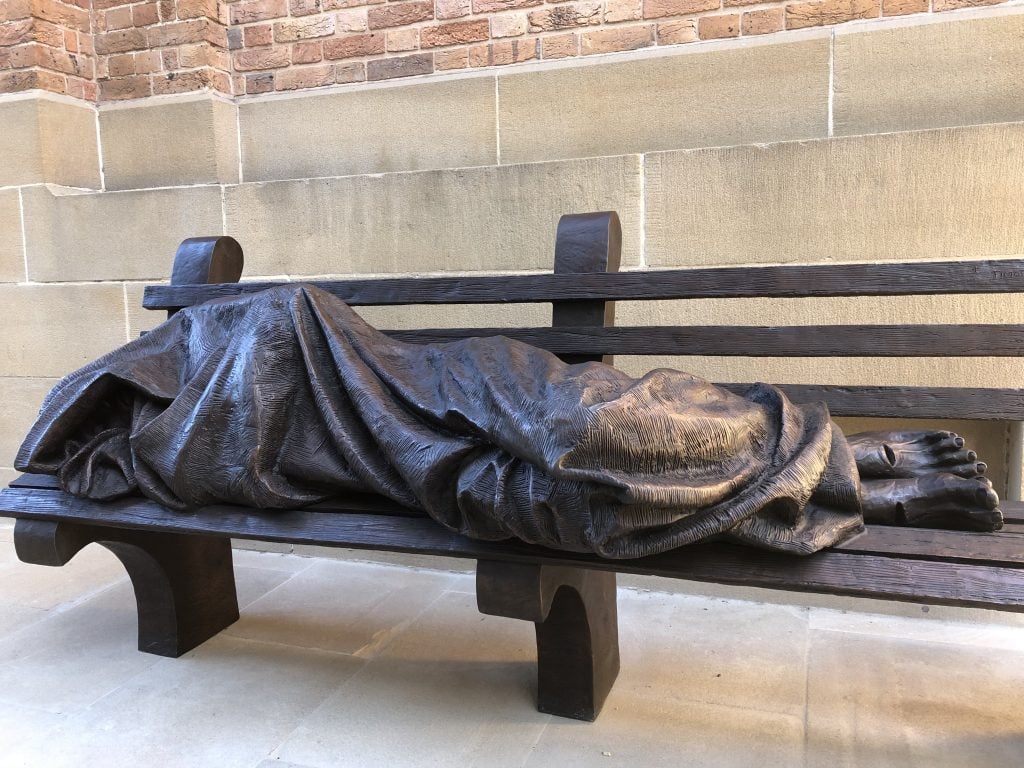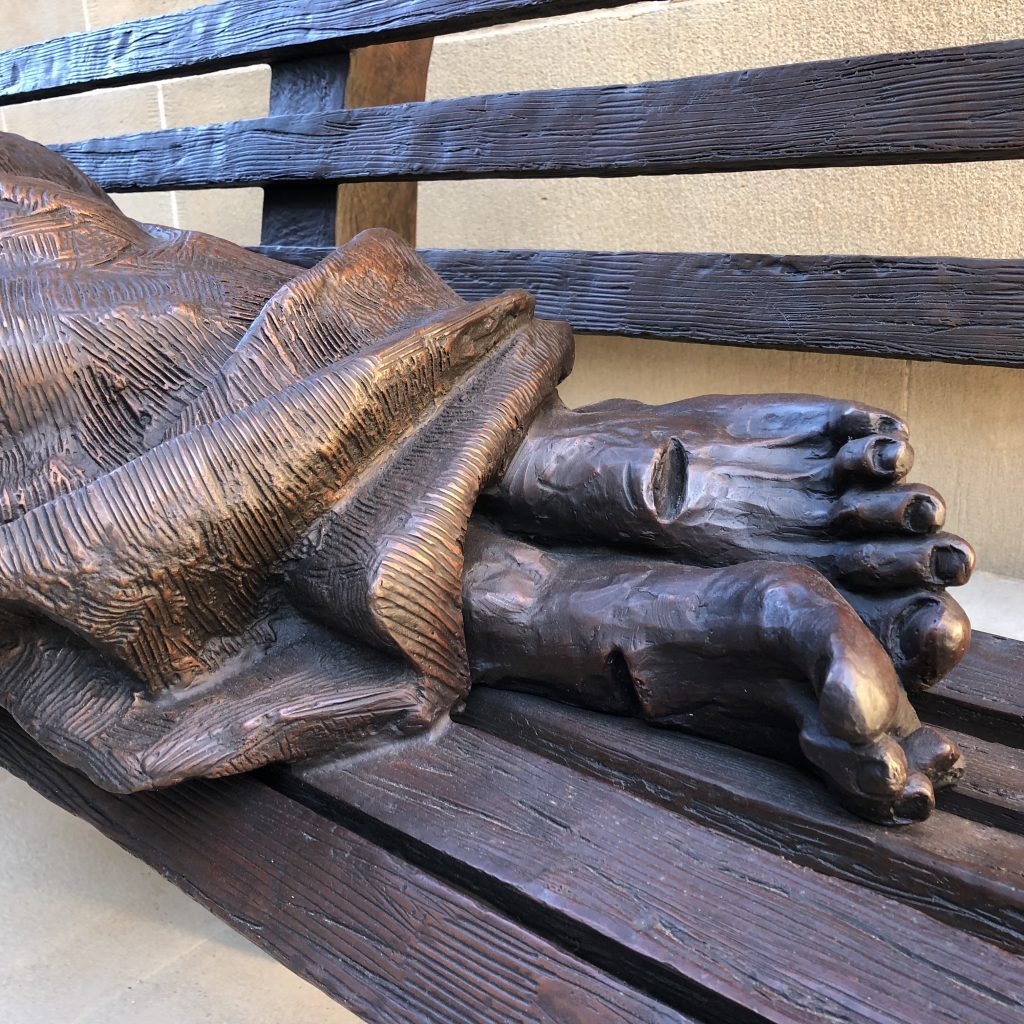Have you seen Homeless Jesus?
A controversial sculpture is changing how we see life on the streets
In an unassuming corner of a busy Sydney street, a crumpled figure lies sleeping on a park bench. The scene is so familiar that no one looks twice at this homeless person amid the hustle of a CBD lunchtime. But an observant eye would notice a few surprising details:
- The bench is in the grounds of a church – St James’ Church in King St, Sydney, to be precise
- The figure isn’t moving; it is statue-still
- The feet of this man, protruding from his blanket, bear deep gashes
The figure is, in fact, a statue of the “Homeless Jesus.” The bronze sculpture, unveiled by St James this week, is the latest in a series of about 100 Homeless Jesus statues throughout the world.
The artwork crops up in Italy (in the Vatican), Canada, the United States, the United Kingdom, Ireland, India, Argentina, Spain, South Africa and Poland. This is Australia’s second Homeless Jesus, with another in Toowoomba, Queensland.
“I couldn’t let go of thinking that I had just witnessed Jesus.” – Timothy Schmalz
Canadian artist Timothy Schmalz has been creating Christian sculptures for almost 30 years and the idea for Homeless Jesus was born when Schmalz was driving past people living on the streets in Toronto.
He describes the experience: “I found myself shocked. There was one person in particular, who was completely covered up in a blanket. There was something haunting about that – this fragile human form in stark contrast to all the busyness surrounding them. I just felt that I saw Jesus. I couldn’t let go of thinking that I had just witnessed Jesus.”
“So I went back to my studio and, about a week later, I thought maybe I could create a sculpture that would make other people have that experience.”

This resulted in the first Homeless Jesus about five years ago. Since then, the Homeless Jesus has taken on a life of its own, with regular commissions for the statue around the world. “The sculpture is becoming almost a movement, more than just an ornament,” says Schmalz. He notes that the cross-cultural appeal of the sculpture may stem from its ambiguity. The face of the statue is deliberately concealed, so that everyone can connect and identify with the Jesus it portrays.
The sculpture is intended to be “a visual translation of Matthew 25.” In that chapter of Matthew’s gospel, Jesus likens himself to a homeless person to teach about the need for compassion (see Matthew 25:34-46).
“I love how Matthew 25 reveals slowly the point … It’s almost like you have that eureka moment when Jesus reveals that whenever you’ve helped the least, you’ve done that to [him],” says Schmalz.
“Like this passage, the sculpture reveals almost at the end of the visual experience that it is Jesus … At first you just see it is a statue of a homeless person but with closer investigation, you realise it’s Jesus.”
There have, in fact, been many reports of the sculpture being mistaken for a real person. In one city it has even provoked numerous calls of concern to the police and paramedics.
“Some people find it very shocking.” – Timothy Schmalz
As well as the surprising design, the sculpture’s unique portrayal of Jesus has also caused controversy.
“Visual art is a very powerful way of preaching. Some people find it very shocking. But I like to say that it’s only as shocking as the gospels are,” says Schmalz.
“We’re used to seeing a ‘comfort food’ Jesus. I think this is a more authentic representation as it’s based on Jesus’ words.”
There is no denying the positive impact of the sculpture in drawing attention to the growing issue of homelessness across the world. This impact can be attributed, in part, to one deliberate design feature. The sculpture invites you, quite literally, to sit at the feet of Christ.
Schmalz explains: “Sitting on the bench while I was sculpting the Jesus figure, I thought, my goodness I have never really gotten close to a homeless person. Isn’t it interesting that there is often a bubble that we create, or a forcefield that we put in place, so we don’t get too close to the marginalised people?”
“So I thought, I’m going to put an invitation here. I going to put a place to actually sit and touch the sculpture, perhaps pray, perhaps to meditate.”
He describes an encounter with a homeless man in New York, who said the sculpture had become “his place of prayer”. Indeed, his homeless community had a sense of ownership for the statue and viewed it as “their monument”.

For Rector of St James’ Church, Andrew Sempell, this is the key reason for commissioning Sydney’s Homeless Jesus statue.
“There are so many homeless people who live in the area around the church, and St James has had a long ministry to people in need here in the city. So the statue seemed like a very appropriate statement about who we are and the people we engage with.”
While some people see the sculpture as “too confronting”, Sempell welcomes this controversy as a way to open up discussion. In particular, he hopes the statue will make an impact on the powerful leaders in this area, and highlight to them the many homeless in the city.
“St James is in what is called ‘the big end of town’. We have the Supreme Court building opposite, Parliament House just down the street, offices of all the great corporations, and the banks and financial institutions all around us. We are in a space where the good and great inhabit this space every day. In the midst of all of that, we are making a statement that there are other people here in the city, and we recognise them,” says Sempell.
“So, as people walk past the statue, we would like them to come to the realisation that here is a homeless person, but it also the presence of Christ in this city … We pray that it might be a reminder of the call to ensure the provision of justice for all people.”



